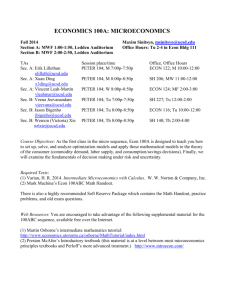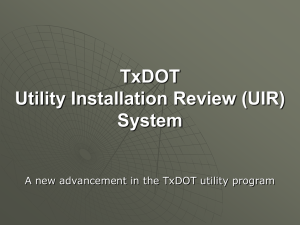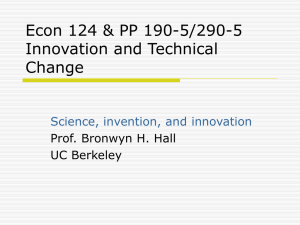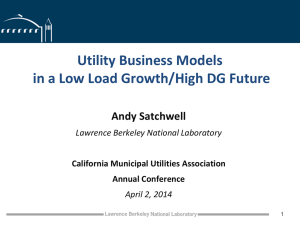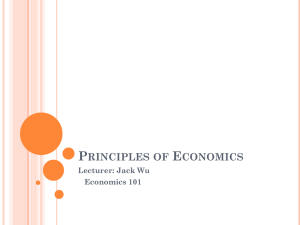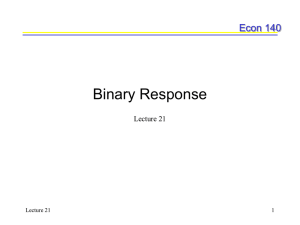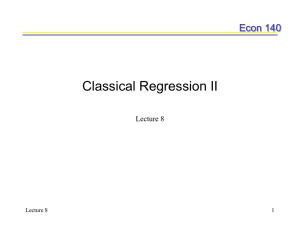Public Finance - UCSB Economics
advertisement
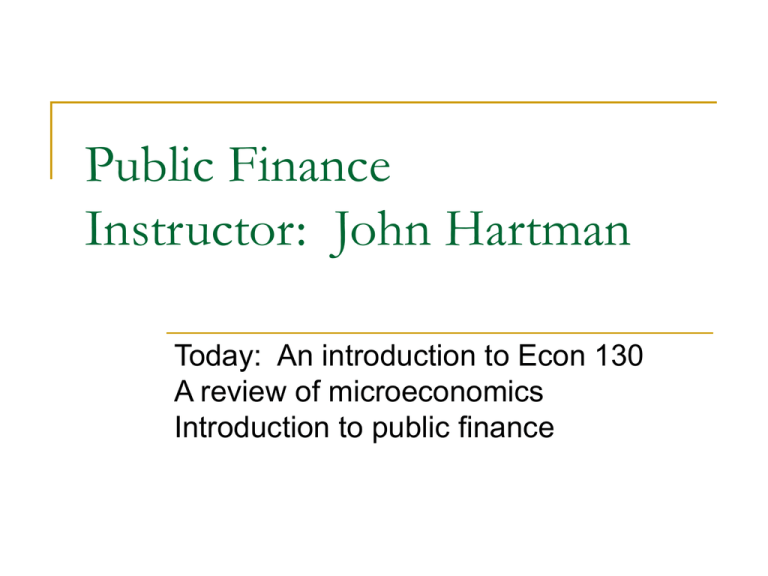
Public Finance Instructor: John Hartman Today: An introduction to Econ 130 A review of microeconomics Introduction to public finance Before we begin… Remember that this is a small class Ask questions if things are not clear The syllabus is posted online See http://econ.ucsb.edu/~hartman/ For most of you, attendance is important if you want to get a good grade Before we begin… I expect you to know the following tools Calculus Microeconomics Econ 1, Econ 100A or 104A, Econ 100B or 104B Macroeconomics (although not as important for public finance) Derivatives, integrals, partial derivatives Econ 2, Econ 101 or 105 If you are lacking on any of these skills, please make sure you are comfortable with these skills by next week Structure of learning Expected time to spend on this class 3 hours per unit per week 12 hours per week total Format of learning Read first Lecture Do problems on your own Solve problems in class and review sessions Textbook for this class Rosen/Gayer Public Finance, 8th edition Published by McGraw-Hill/Irwin Office hours and review sessions Office: NH 2028 Office hours: Mondays 10:30-11:30 am Wednesdays 9:30-10:30 am I plan on conducting one review session before each test Time and location to be announced Tests Three tests, as of now scheduled for: Monday, April 28 (in lecture) Monday, May 19 (in lecture) Monday, June 8 (final, 4-6:30 pm) Some problems on tests will be similar to what we cover in practice problems Some questions will require you to learn material and think your way through Lecture slides I will post a subset of lecture slides on-line Usually posted 2 days to a week before lecture Tables and figures from your textbook will often not be posted On-line slides are not meant to be a replacement to lecture Grading If you do not miss a test: Two best tests count 40% each Lowest test counts 20% Exception: If your best test is the final, the final will count 60% and the other two tests count 20% each If you do miss a test, check the syllabus for details Grading Typical upper division Econ field class curve 20-25% A+, A, or A30-35% B+, B, or B25-30% C+, C, or CRemaining students: D+, D, D-, or F However, I will reward the class if you score well as a group More on this class Early on, I will lecture the entire time Later on many lectures will be about 55-60 minutes, followed by problem solving Some classes will be devoted to a single topic Some classes will consist of two to four “minilectures” Problems Each week, I will post a few problems The following week, I will solve some of the problems at the end of each lecture, as time permits I will also solve some problems at each review session Today An introduction to Econ 130 A brief review of Microeconomics (read Appendix) What will we cover over the next 10 weeks? Supply, demand, and equilibrium Utility Budget constraints Substitution and income effects Consumer and producer surplus Introduction to public finance: Begin Chapter 1 An introduction to Econ 130 This class covers four “units,” each with three to five lectures Unit 1: Introduction and Microeconomic tools Unit 2: Public goods, externalities, and government Unit 3: Health care and income redistribution Includes guest lecture by Ted Bergstrom Tentative topic: Bone marrow as a public good Unit 4: Primary and secondary effects of taxes Unit 1 (begins today) Introduction and Microeconomic tools Appendix: Microeconomics review and marginal analysis Chapter 1: Introduction to public finance and government Chapter 2: Empirical tools Chapter 3: Economic theory tools Chapter 8: Cost-benefit tools Unit 2 Public goods, externalities, and government Chapter 4: Chapter 5: Chapter 6: Chapter 7: Public goods Externalities Government and political economy Government spending on education Unit 3 Health care and income redistribution Chapter 9: Problems of insurance in the health care market Chapter 10: Government’s role in health care Chapter 11: The structure of Social Security; stresses caused by the baby boom generation Chapter 12: Conceptual issues of income redistribution Chapter 13: Programs for the poor Unit 4 Primary and secondary effects of taxes Chapters 14 and 15, and parts of Chapter 16: Taxation, income distribution, and efficiency Parts of Chapters 17-21: Taxation on the national level Personal taxes Corporate taxes Deficit finance Tax reform Chapter 22: Taxation on a state and local level Microeconomics review Some topics you should already know We will assume standard cases If you need review on these topics, look in the Rosen/Gayer (“R/G”) appendix, or books that you used in introductory or intermediate microeconomics classes Supply, demand, and equilibrium In equilibrium, the supply and demand curves intersect When quantity supplied is higher than quantity demanded, there is a push for prices to go down Excess supply When quantity supplied is lower than quantity demanded, there is a push for prices to go up Excess demand Supply and Demand Equilibrium: Q = 4, P = 6 Example of excess demand Factors of demand Price: Higher price lower quantity demanded Income: Most goods are normal Normal goods: Higher income means higher demand Price of related goods (complements, substitutes) “Tastes and preferences” Factors of supply Price: Higher price higher quantity demanded Price of inputs Technology Weather Shift in demand; movement along supply curve Utility Utility is used by economists to note a level of satisfaction The higher the utility, the higher the satisfaction Bananas and utility Notice this example, where the utility level is a function of the number of bananas consumed Common unit of utility is called a “util” Typically assume non-satiation Banana quantity (bananas) Total utility (utils) 0 0 1 70 2 120 3 150 4 160 5 165 Two goods and utility An indifference curve that is further from the origin has higher utility U2 Increasing utility U1 U0 U2 > U1 > U0 Budget constraints We assume each person has wants that are above the resources available to her/him Consumption must be made from resources available Budget constraints with no money Becky has a given number of hours per day Feasible bundles: t, v, w, x, y, z Point t does not use up her time allotment Point u is infeasible Budget constraints with no trade If there is no trade: Becky chooses production to maximize her utility This occurs where budget constraint is tangent to an indifference curve Point E1 E1 Substitution and income effects When the price of a good changes, two things happen Income effect: How much does quantity change due to lower income? Substitution effect: How much does quantity change due to change in relative prices? Substitution and income effects Income effect Substitution effect E1 to Ec Ec to E2 Note that budget lines to calculate income effect are parallel Consumer surplus Height of triangle is ($6 – $3), or $3. Length of triangle is (6 – 0), or 6 Area of triangle is onehalf times length times height CS = $9 The area of this triangle is a good approximation of CS Producer surplus When P = 25 per unit, shaded area is approximate producer surplus Area is a triangle, onehalf times length times height 0.5 10 25 = 125 Summary: Microeconomics review Many microeconomic tools are needed to do public finance Some of the tools that we will use are based on supply, demand, utility, and budget constraints Introduction to public finance This class is meant to cover public finance to students that have no direct background in the topic Two topics will be covered in this “mini-lecture” Some knowledge on public goods and externalities is useful, but not required What is studied in a public finance class? What kinds of views do people have about public finance? Government will be addressed more in later lectures Size of government will be covered in the next lecture Growth of government will be covered in week 4 Public finance Public finance, as defined by R/G (p. 2) “The field of economics that analyzes government taxation and spending policies” Public finance, as described by Former Czech Prime Minister Vaclav Klaus (From R/G, p. 2) “Public finance is nothing else than a sophisticated discussion of the relationship between the individual and the state” Public finance We will study topics in which many argue that government intervention is justified Public goods and markets with externalities Subsidized education Health care, Social Security, and income redistribution Public finance and taxes Many programs require tax money to operate We will study how the governments on the local, state, and national level operate Personal income tax Reaction to labor/leisure choices Corporate taxes Deficit financing Potential reforms to the current tax structure Public _____ There are at least two other terms that mean the same thing as public finance Public sector economics Public economics Although I may use the three terms interchangeably to mean the same thing, I will usually use the term “public finance” What views do people have? Different people have different views about public finance Organic view of government Mechanistic view of government Organic view of government Government treats an entire society as a natural organism Each individual is part of the organism The government is the heart Although individual goals differ, some goals are naturally needed for the societal organism Mechanistic view of government Government is needed for individuals to pursue their individual goals “Invisible hand” (Adam Smith) Efficient markets under certain sets of conditions Property rights and lack of violence needed to have efficient markets How much government beyond this is debatable Libertarian: Small government Social democrats: Larger government needed What this class does Some analysis is done on a society-wide scale Social costs and benefits Cost-benefit analysis on a nationwide scale Other topics talk about individual analysis Voting theory Individual reaction to taxes and credits on labor Determining what is “good” What is “good” to one person may be viewed as bad as others Let’s do an activity to illustrate this Everyone starts by standing up I will show a statement Stay standing if you agree with the statement Sit down if you disagree with the statement There is no “right” answer to any question Time to stand up Statements 1-3 I believe that reckless driving should be stopped through government actions (such as the use of police) I think that government should build and maintain roads and highways I believe that each baby needs to be securely buckled into a car seat while riding in a car, to be enforced by the government Statements 4-6 I believe that each person in a moving car needs a seat belt on, to be enforced by the government I believe each driver needs liability insurance, to be enforced by the government I believe the government has a right to regulate when each person can use the roads, and the route they take, in order to control traffic patterns Statements 7-9 I believe that the government has a right to prevent pilots of commercial aircraft from using a cell phone while actively flying I believe that the government has a right to prevent drivers of cars from using a cell phone while driving I believe that the government should charge a 90% tax rate on all income I earn in my lifetime Does everyone agree? No Different people have different opinions about what the government should do Experts often disagree about what government should do We will often assume that the experts in other disciplines have gotten costs and benefits right Summary: Introduction to Public Finance Many topics studied in public finance Topics related to government intervention Tax-related topics Different viewpoints about government Organic view Society is an organism Mechanistic view Government used to reach individual goals Some ground rules at the end of lecture I will always try to be done by 3:15 pm In return, I expect your attention until the final slide If you must leave early: Please do so no later than 3:05 pm Sit near an exit Leave quickly and quietly Example of final slide Some ground rules at the end of lecture After many of the lectures Problem solving Your questions (especially near test time) Review of test questions You are welcome to leave after lecture is finished Please do so quickly and quietly
